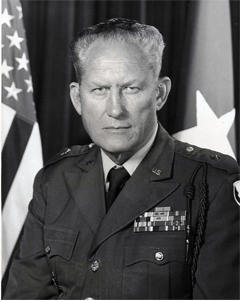Brigadier General
Anthony F. Daskevich
 Anthony F.
Daskevich began his Army career as an enlisted soldier in 1941. Rising through the ranks, he received a
battlefield commission during World War II and led a tank platoon in combat in the European Theater. In
1951, following an assignment as a maintenance officer in Germany, he transferred from the Armor Branch to
the Ordnance Corps and took command of the 18th Ordnance Medium Maintenance Company in Germany.
Anthony F.
Daskevich began his Army career as an enlisted soldier in 1941. Rising through the ranks, he received a
battlefield commission during World War II and led a tank platoon in combat in the European Theater. In
1951, following an assignment as a maintenance officer in Germany, he transferred from the Armor Branch to
the Ordnance Corps and took command of the 18th Ordnance Medium Maintenance Company in Germany.
In his next assignment as an instructor for the Officer Basic and Advanced Courses at the Ordnance School, he was given responsibility for revising Field Manual 9-10, the only Army publication dealing with Direct Support maintenance operations at the time. Much to his credit, he applied lessons learned as a maintenance company commander and combat veteran to update and improve field maintenance doctrine.
Following assignments as Ordnance Advisor to the Venezuelan Army and as a project officer on the Ordnance Board, which was subsequently incorporated into the Maintenance Agency, Combat Developments Command, Aberdeen Proving Ground, he took command of the 4th Ordnance Battalion (Maintenance and Supply) in Korea. This battalion integrated all non-divisional Ordnance, Signal, Engineer Maintenance, and Quartermaster units in South Korea and was one the precursors of the multi-functional corps support battalion. Under his leadership, the 4th Ordnance Battalion developed the standing operating procedures necessary for these diverse units to function as a team.
From 1966 to 1969, he was assigned to Combat Developments Command, most notably as the project officer for a Department of the Army project known as Combat Operational Loss and Expenditure Data-Vietnam (COLED-V). Within three months, he devised a collection plan and organized teams to collect data on combat vehicles damaged by enemy artillery and assess artillery ammunition expenditure rates. The results led to improvements in vehicle survivability and laid the groundwork for developing revised ammunition expenditure tables.
Concurrently, he was tapped to support a Department of Defense project for Utilization and Redistribution of Material in the Pacific Area (PURM). Here again, he and his team excelled. Under LTG Heiser's guidance, they developed an inter-service plan to identify and redistribute excess material that, in turn, helped the government avoid both unnecessary new procurement and drains on existing depot stocks.
He culminated his career in a number of key assignments: Commander, Tooele Army Depot, 1969 to 1971; Commander, VII Corps Support Command, 1971 to 1973, and Deputy Commanding General, US Army Tank-Automotive Command (TACOM), 1973 to 1975. At TACOM, he overhauled the wholesale supply operation, improving stock availability from 58 to 85 percent, and established a liaison program with the divisions and separate regiments specifically designed to address the units' readiness problems.
BG Daskevich retired in 1975 after 34 years of service, 24 of them as an Ordnance officer who made a wide range of contributions to the Corps.